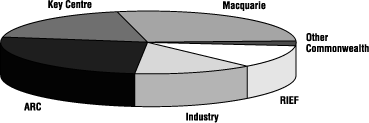GEMOC funding
background
WHEN GEMOC STARTED in 1996, it had a research funding base (from ARC) exceeding that provided by DETYA for the Key Centre. The continuation of GEMOC relies on maintaining a minimum of this existing funding level from non-Key Centre resources for research projects. This budget strategy is integral to ensuring that GEMOC is viable beyond the DETYA funding cycle by requiring that research projects are competitive on the open market and do not become dependent on the Key Centre funding. This strategy was ratified at our mid-term review in 1998. Hence no mature research projects are funded from GEMOC DETYA funds as documented for the original contract with DEETYA.
The Key Centre funds are used as forecast in the original projected budget for:
- new expertise (part funding postdoctoral fellows, lecturer, professorial fellow)
- gaining leverage for other funding
- new initiatives (seeding and pilot projects)
- dedicated specialised infrastructure
- networking
- scholarships and support to encourage Honours and postgraduate participation
- international visitor program including continuation of China Links
- operating funds including publicity
- some support of the Director's research since the ARC rules for grant eligibility were changed after GEMOC's business plan had been implemented
strategy for continuation beyond 6 years
background
The guidelines for this round of Key Centres required a strategy for funding continuity beyond the six years of Commonwealth Key Centre funding
budget continuation
Management of the DEETYA funding is designed to provide leverage as shown by the following examples:
- Research operating money is a small budget item and is allocated for pilot studies or strategic opportunities only. No mature research programs have been funded by the Key Centre.
- Industry involvement and interaction creates collaborative links of mutual benefit and a basis for long-term research funding.
- High-technology infrastructure is supported by strategic alliances with manufacturing and development companies.
- Macquarie University is providing transition funding for a two-year period after DETYA direct Key Centre funding ceases (end of 2001 after roll-over).
- Macquarie University has provided funding for geophysical modelling staff for a two-year transition period.
postgraduate funding
- New postgraduate scholarships provided to the Key Centre from 2000 (effective from 2001 and beyond) provide assured placement for outstanding students.
- Other programs are funded by industry.
- Exchange agreements with Nanjing University and China University of Geosciences allow for waiving of fees for postgraduate students.
- Exchange ("Co-tutelle") agreement with the University of St Etienne enables postgraduate links with international co-supervision.
equipment and analytical funding
The geochemical facilities are a high-budget item in terms of maintenance, running costs, replacement and especially for new purchases to maintain frontline developments. These facilities are vital to all of the four GEMOC programs and to attracting research and industry income. Funding strategies in place include:
- User-pays system for running, maintenance and development costs
- University annual contributions through competitive schemes and capital equipment allocations
- Annual contribution from the Department of Earth and Planetary Sciences
- Macquarie University's guarantee of a strategic plan to ensure the integrity, maintenance and appropriate staffing of the Geochemical Analysis Unit
- R&D (Research and Development) ventures with manufacturers leading to equipment replacement
- Applications to funding schemes (eg ARC Research Infrastructure) for matching funds for new purchases
- Provision of services to external clients including industry
- Industry capital investment in return for access equity, negotiated intellectual property and collaborative rates for access time
GEMOC INCOME 2000
This is a summary of 2000 Income. A full audited statement of detailed expenditure and income is provided to DETYA every June. No in-kind support is included.
| $1000 | |
| DETYA KEY CENTRE FUNDING 2000 | 493.4 |
| ARC | |
| Large ARC grants (Macquarie and ANU) | |
| new for 2000 | 216.4 |
| ongoing | 311.6 |
| Small ARC | 133.3 |
| IREX | 20.3 |
| SPIRT | 132.0 |
| RIEF | 330.7 |
| OTHER COMMONWEALTH | |
| Postgraduate awards | 44.7 |
| ACILP, ASAC, DIST | 12.8 |
| INDUSTRY | |
| Macquarie (including industry contribution to SPIRT) | 168.1 |
| ANU (AMIRA) | 73.7 |
| INTERNAL UNIVERSITY | |
| Macquarie | |
| Annual Key Centre contribution | 100.0 |
| Postdoctoral Fellowship | 46.5 |
| Internal competitive Grants | 61.1 |
| External collaborative research grants | 52.1 |
| Postgraduate awards | 105.2 |
| Infrastructure (RIBG) | 129.2 |
| Equipment | 170.0 |
| GAU maintenance | 35.0 |
| Macq contrib to RIEF | 120.0 |
| External RIEF contrib (Newcastle Uni, MRL) | 50.0 |
| TOTAL | 2804.1 |
2000 EXPENDITURE OF DETYA ALLOCATION
This is a summary of 2000 expenditure A full audited statement of detailed expenditure and income is provided to DETYA every June.
| EXPENDITURE CATEGORIES | $000 |
| Salaries | 247.9 |
| Honours and Postgraduate support | 39.3 |
| Travel | 6.5 |
| (Includes some support for Honours and Postgraduate projects and GEMOC Advisory Board Meetings) | |
| Equipment | 29.2 |
| Director funds for research support* | 64.2 |
| International Links Support | 16.0 |
| Consumables | 13.5 |
| (Includes some support for Honours and Postgraduate projects) | |
| Operating funds | 32.7 |
| (includes publicity) | |
| Commitments | 44.1 |
| (Salaries, Honours and Postgraduate support) | |
| TOTAL | 493.4 |
| 2000 DETYA allocation | 493.4 |
| * due to change in ARC policy re eligibility of Director for Large ARC and SPIRT grants |
Pie chart of income sources 2000


 GEMOC ARC National Key Centre
GEMOC ARC National Key Centre